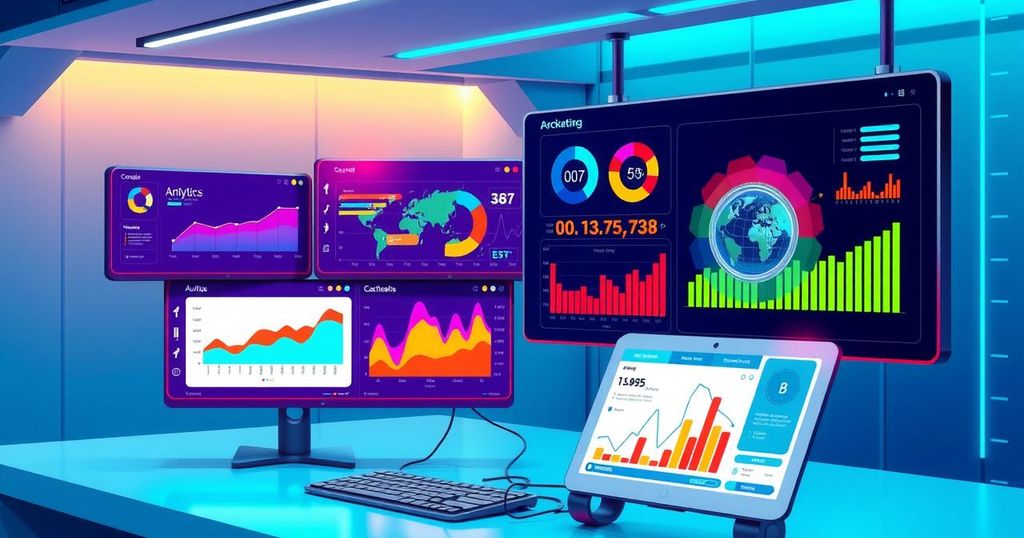How AI Is Transforming the Marketing Landscape
AI is revolutionizing marketing, enhancing efficiency and creativity while providing valuable data insights. Teams are leveraging various tools for automation, personalization, and real-time adjustments, significantly improving campaign outcomes. Despite challenges related to data accuracy and potential lack of personal touch, AI has established itself as an essential component of modern marketing strategies.
As artificial intelligence continues to weave itself into the fabric of marketing, it’s transforming the way brands connect with consumers. No longer a passive tool, AI is empowering marketers to create content, target specific users, and achieve results increasingly faster. These platforms analyze massive amounts of data, guiding teams toward smarter, swifter decisions. In short, AI isn’t just a passing trend—it’s a cornerstone of contemporary marketing strategies.
What’s fascinating about AI in marketing is its ability to enhance creativity rather than stifle it. These intelligent systems allow teams to discover patterns, conduct real-time testing of ideas, and optimize campaigns as they unfold. This results in a marketing environment that’s not only more efficient but also more personal and approachable.
Jumping right into what AI marketing entails, it combines artificial intelligence and machine learning to steer marketing efforts. At its core, it helps brands dissect data into actionable strategies. Everyday tools—think chatbots, automated blog drafts, or targeted analytics—are helping cut out guesswork, significantly boosting campaign effectiveness.
A majority of AI tools harness data from social media, emails, and websites, ranging from ideation to outcome. However, running these sophisticated systems often requires support from engineers or data scientists. So, while the tools themselves can be user-friendly, backing them up with technical expertise is vital.
Marketers are embracing AI to up their game, speeding up processes and avoiding guesswork. The everyday benefits are tangible:
Automation comes into play with tools like Zapier that manage tasks such as post-scheduling. Personalization shines through platforms like Amazon, which recommends products based on user behavior. Meanwhile, audience segmentation is evident in Spotify’s smart targeting of listeners.
To take a deeper look at how AI is revolutionizing marketing, consider some practical applications:
– Email Marketing: Mailchimp’s cutting-edge tech selects optimal send times and subject lines based on user activity—boosting click-through rates with zero manual effort.
– Landing Pages: Unbounce tests and refines layouts automatically, fine-tuning what resonates with users to enhance performance.
– Social Media: Tools like Buffer and Sprout Social provide insightful analytics on post performance, suggesting the ideal times to share.
– SEO Improvements: Surfer SEO and Clearscope identify trending keywords and provide essential updates for content strategies.
– Personalized Content: Platforms like Dynamic Yield tailor content in real-time, responding to user interaction seamlessly.
The advantages of leveraging AI in marketing extend beyond just efficiency. Teams now experience faster decision-making thanks to AI tools like Jasper, which provide instant insights through predictive analytics. This means marketers can predict outcomes ahead of launches. More targeted efforts translate into improved return on investment (ROI) and better allocation of resources.
Data-driven insights push teams forward without the wait. Monitoring key performance indicators gets instantaneous. Jasper connects campaign actions back to performance trends—allowing swift adjustments without downtime. Furthermore, AI systems enhance customer relationship management (CRM) by organizing contacts and suggesting replies, maintaining a human touch.
There are plenty of names making waves in this space:
– Jasper: The go-to for rapid content generation.
– ChatGPT: A collaborator for drafted communications.
– Copy.ai: Focused on testing and optimizing landing pages.
– Grammarly: Polishing tones and grammar.
– Imagine Art: Converting text prompts into striking visuals.
Jasper stands out because it’s tailored specifically for marketing—a tool designed with only marketers in mind. It offers seamless integration into workflows, ensuring that every part of the process ties back to campaign objectives and performance metrics.
When deploying AI in marketing, here are some best practices to keep in mind: first, articulate clear goals. Clean, accurate data is crucial, and it’s essential to regularly review outputs for errors. Awareness of potential bias in algorithms can prevent messaging mistakes, too. Transparency within your team about AI’s role is key, and everyone should be trained on tool functionality.
Integrating AI into marketing isn’t rocket science. Start by defining your goals clearly. Select tools that address specific marketing needs, and then train these tools on historical data for accuracy. Launch small campaigns to test effectiveness, monitor the results closely, and tweak your approach based on what you learn.
AI is reshaping digital marketing in profound ways. From crafting content to audience analysis, every part of the marketing machine becomes more efficient. Not only do these tools enhance operational speed, but they also help in managing campaigns more accurately. Firms leveraging AI can swiftly adapt their messaging and improve engagement, ensuring they stay relevant in crowded marketplaces.
On the flip side, AI marketing is not without challenges. Reliability hinges on clean, unbiased customer data—outdated information can skew results. Plus, an over-reliance on machines can dilute personal touch, resulting in robotic communication that lacks authenticity. Marketers must remain vigilant about how tools utilize data and ensure ethical standards are upheld.
As we look ahead, AI in marketing is set to evolve further. Generative AI is paving the way toward creating comprehensive campaigns—from images to intricate videos. The ability to adapt marketing strategies in real-time is at our fingertips, promising faster and better outcomes. Reports suggest that by 2025, a staggering number of marketing leaders plan to escalate their AI investments.
In summary, AI’s presence in marketing is profound and here to stay. With the potential to enhance workflows and reveal valuable insights, teams must navigate this landscape thoughtfully. By defining clear strategies, selecting appropriate tools, and respecting data sovereignty, companies can thrive in the age of AI marketing.
In conclusion, AI is reshaping the marketing landscape in significant ways—from content creation to customer relationship management. It offers smarter, faster decision-making and deeper insights into consumer behavior. However, marketers must tread carefully, maintaining a balance between leveraging AI and preserving human touch. Ultimately, success hinges on aligning AI tools with strategic goals and upholding ethical practices in data usage, ensuring that human judgment guides technological capabilities. Companies that adapt early stand to gain a competitive edge in the evolving marketplace.
Original Source: www.greenbot.com




Post Comment